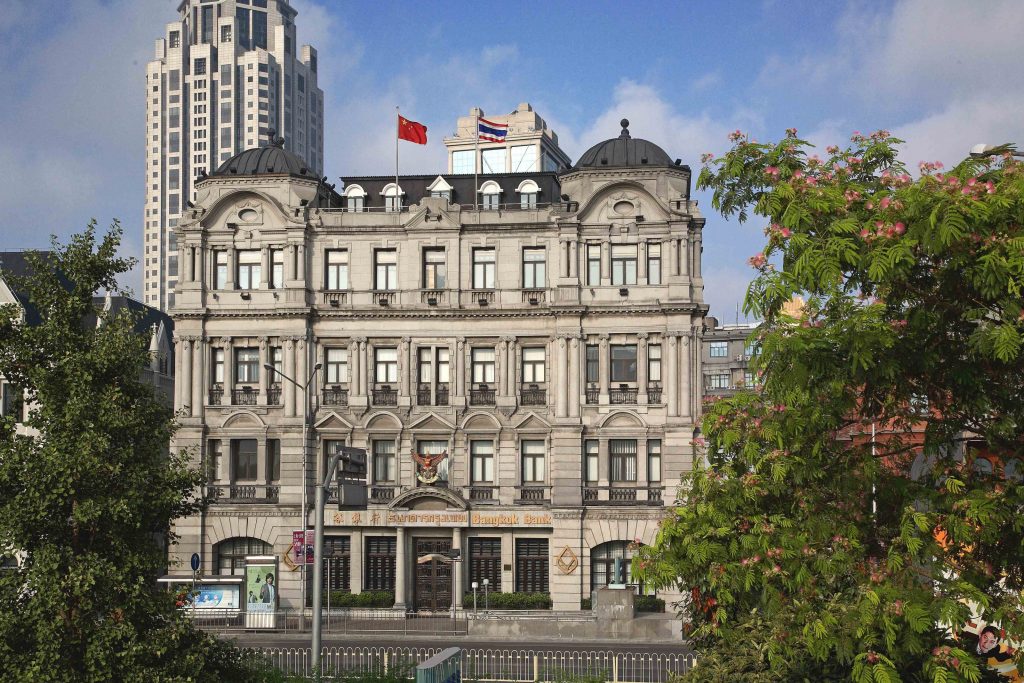The Bangkok Bank is a branch of Bangkok Bank Public Company Limited, was formerly the Great Northern Telegraph Company and has had a presence in Shanghai since 1931. Although the owners of the building have changed over decades, the architecture itself has remained one of the classic buildings on the Bund. It reflects the potential negotiation between the local Chinese and the foreign Thai from the age of treaty port culture through its design plan, material structures, and facade.
The initial engagement between the foreign Bangkok bankers and local landowners found visual evidence from the design plan of the towers and flags. From the design plan’s architecture, viewers see that the bank is designed as bilaterally symmetrical with an extended tower and a national flag on each side of the building. The towers, designed with a European Renaissance style, indicate potential interaction. (I’d like to learn how and why the towers in renaissance style would promote interactions) The towers are located on each side of the building as though they are two negotiators. The connecting structure between the towers simulates two negotiators placing their arms on each other’s shoulder, displaying a reached agreement. In addition to the towers, the flags, Chinese on the left, Thai on the right, indicates the identity of the two negotiators. With the interactions simulated by the towers and national identities defined in terms of the flags, the symmetrical layout of the two reflects the amicable relationship between the native and the foreign.
To further refer to the idea of negotiation, the Bangkok bank architecture shows credibility to local landowners. The Thailand bankers’ reliability and dedication will find visual evidence from the bank’s material structures, the black rooftop and white facade. The black enamel rooftop, presented in a rococo-style, simulates a gentlemen’s tophat. The white walls, built in masonry, provide the appearance of a neat dress shirt. The black rooftop and the white wall integrate perfectly creating the image of a well-dressed authoritative gentleman who will treat the banking business seriously. The combination of the black rooftop and white walls (color is addressed and how about the materials itself?) gives the building a sense of solemnity and elegance. The material structure of the Bangkok Bank asserts the intention of continuing engagement of the Thais with the Chinese.
Successful cooperation finds visual evidence in facade’s focal point, the Garuda. This bird-man creature is the national emblem of Thailand and is awarded by the Thai Royal family to outstanding companies. The body of the Garuda is red like the Chinese flag, indicating Thai people keep the needs of the local Chinese in mind. Around the body, the Garuda extends his golden wings, a sign of limitless future opportunities with the Chinese. Overall, the Garuda displays a gesture of flying in the sky, signaling the triumphant collaboration with the local Chinese. In addition to the physical features of the Garuda, its position on the facade also indicates architecture choice. Garuda is being geometrically arranged at the lower central axis of the building. The placement meets with the viewer’s eye level and will become the most eye-catching feature of the building. Being the focal point, the Garuda symbolizes a successful bridge between the Thai and Chinese. The facade of the Bangkok Bank presents the successful engagement of the Thai in Shanghai.
Overall, the Bangkok Bank on the Bund exemplifies a successful communication and documents the history of Thai interactions within China. Through its design plan, material structures, and facade, this bank building articulates the diligence Thai foreigners maintained in order to win the trust of the Chinese during the age of the treaty port.


